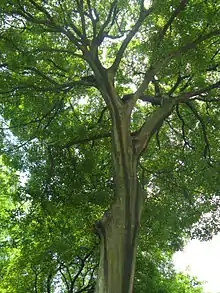Celtis sinensis
Celtis sinensis (English: Chinese hackberry; Chinese: 朴树) is a species of flowering plant in the hemp family, Cannabaceae, that is native to slopes in East Asia.[2]
| Chinese hackberry | |
|---|---|
 | |
| Mature tree at Yuelu Academy | |
| Scientific classification | |
| Kingdom: | Plantae |
| Clade: | Tracheophytes |
| Clade: | Angiosperms |
| Clade: | Eudicots |
| Clade: | Rosids |
| Order: | Rosales |
| Family: | Cannabaceae |
| Genus: | Celtis |
| Species: | C. sinensis |
| Binomial name | |
| Celtis sinensis | |
| Synonyms | |
| |
Description
It is a tree that grows to 20 m tall, with deciduous leaves and gray bark. The fruit is a globose drupe, 5–7(–8) mm in diameter. Flowering occurs in March–April, and fruiting in September–October.[2]
Distribution, habitat and uses
Native to slopes at altitudes of 100–1500 m in Anhui, Fujian, Gansu, Guangdong, Guizhou, Henan, Jiangsu, Jiangxi, Shandong, Zhejiang, Sichuan , as well as Korea (팽나무),[2] Japan and Taiwan. Leaves and bark are used in Korean medicine to treat menstruation and lung abscess.[3] It is a naturalized non-invasive species in North America. It is a declared noxious weed in many parts of eastern Australia.
As an ornamental plant, it is used in classical East Asian garden design.
 Foliage and ripe fruit
Foliage and ripe fruit_-_Kawahara_Keiga_-_1823_-_1829_-_Siebold_Collection_-_pencil_drawing_-_water_colour.jpeg.webp) Kawahara Collection at Naturalis Biodiversity Center
Kawahara Collection at Naturalis Biodiversity Center Celtis sinensis bonsai at the Parc floral de Paris
Celtis sinensis bonsai at the Parc floral de Paris
References
- "Celtis sinensis". Germplasm Resources Information Network (GRIN). Agricultural Research Service (ARS), United States Department of Agriculture (USDA). Retrieved 2010-02-21.
- eFloras, Missouri Botanical Garden & Harvard University Herbaria, Celtis sinensis, FOC Vol. 5, Page 18, retrieved October 29, 2009
- Park, Kwang woo. 《반응표면분석법을 이용한 팽나무 (Celtis sinensis Persoon) 의 최적 변색제거조건 결정》한국인간ㆍ식물ㆍ환경학회지, Vol.1 No.2| p. 74-84 Accessed in 2013-10-8
External links
| Wikispecies has information related to Celtis sinensis. |
| Wikimedia Commons has media related to Celtis sinensis. |